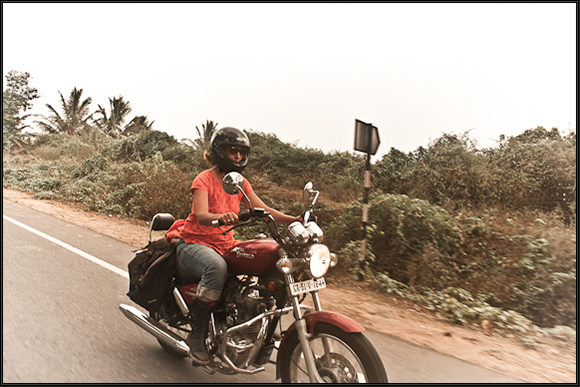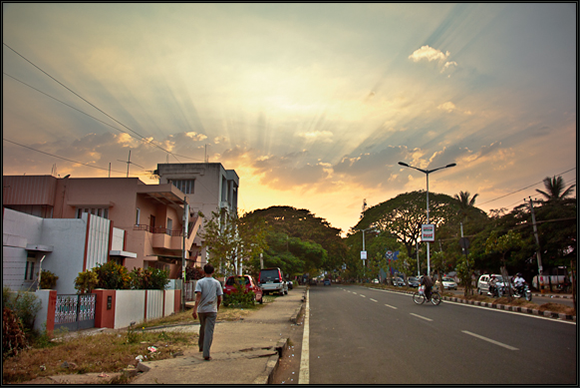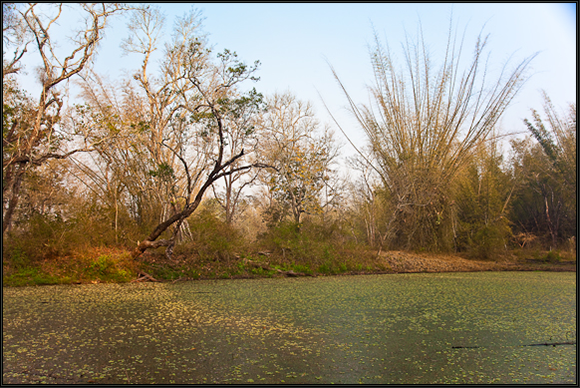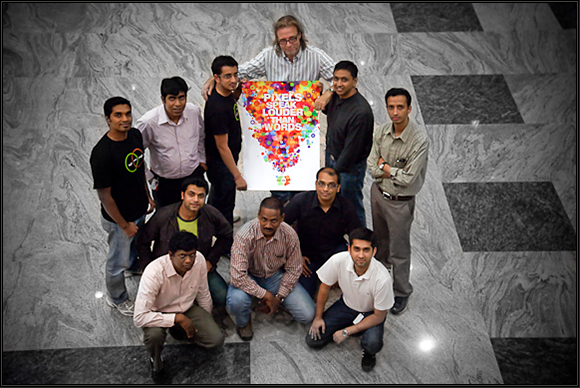
.
I pull around the corner and launch myself into traffic, barely looking to see what I already know is coming at me: a bus, three tuk-tuks, a scooter carrying a family of four, and another scooter with a giant bundle of laundry that the driver is reaching over to steer.
It’s usually best to just focus on the spaces inbetween these things up ahead, and trust that the people behind are doing the same.
In front of me is a blue and white city bus, full to sardine capacity. Without warning, a yellow and black tuk-tuk slips inbetween the bus and me; I swerve, push ahead, and slide back in front of him. A half-block open stretch is pure freedom, with the warm wind and showers of leaves falling from the overhanging trees.
The traffic stops, and I dive into the two-foot wide space between the bus and the cars. I have to tip the bike to the left to avoid the metal rebar that is hanging off the back of an oxcart. A young boy sits on the other end of the pile of metal, piloting two grey beasts whose horns are painted blue and capped with little bronze cones. A stream of scooters and motorcycles crowds in behind me, and we all wait, breathing the billowing exhaust while waiting for the light to turn green.

When we first arrived in Bangalore, and suffered through our first cross-town drive in the back of a taxi, our brains nearly exploded. After twenty minutes, I laid my head on Phil’s lap so I wouldn’t have to watch.
Indian roads, and Bangalore roads in particular, are like a life-and-death video game: anyone, or anything, can come at you from any direction, at any time, for any reason – car, bus, motorcycle, camel, scooter, ox-cart, bicycle, cow, goat, old women, young men, pony carts, monkeys. You must be ready to steer or swerve around them, accelerate, or slam on your brakes at any second. At night it just gets worse because a quarter of the people drive without their lights on, and the other three-quarters drive with their brights on, ensuring that everyone is periodically blinded.
The other hazards (apart from the traffic, the animals, and the people) are the roads themselves. Some sections are smooth and paved, while others are dirt and gravel; most have large random holes where unmarked roadwork is, or was, or might be, taking place. Piles of sand and bricks from construction projects spill out and cover parts of the roadway throughout Bangalore. There are frequent, randomly placed, speed bumps.

We hadn’t planned on learning how to ride motorcycles in India, but Phil fell in love with the Enfields, and I fell out of love with having to depend on a driver. Phil learned to drive the Machismo with me on the back, between 10 p.m. and midnight – the hours between when most Indians go to sleep and when the dogs claim the streets.
We rode through the outskirts, through villages quickly being absorbed by the city, on roads that disappeared into dirt track, while being chased by ragtag packs of feral dogs.
The bike was old, unreliable, and difficult to start. It abandoned us over and over, leaving us in sleepy alleys, surrounded by dogs, and on deserted country roads, surrounded by dogs. We would walk towards civilization with sticks and handfuls of rocks for protection, hopping up and down and shouting when a tuk-tuk rolled by. Then we’d attempt to explain to the driver, with no common language, how to get to our house, while having no idea where we even were.
One Sunday afternoon drive turned into an epic two-day adventure, when the bike’s engine exploded oil all over the highway. We were welcomed into a tiny village by a committee of about 30 children who gave us a house-to-house tour while the mechanic repaired the bike well enough to get us to the next village. In that village we found another Enfield mechanic who finished off the repair. By then it was late, so we found a hotel, spent the night, and the next day we had the most stunningly gorgeous drive back to Bangalore, on a road we would have never found without our mishap.
These breakdowns and mishaps were as entertaining as anything we had set out to do purposefully. Landing in random places has shown us more of India than we would ever have seen otherwise, and the hospitality we were greeted with over and over again made both of us feel quite comfortable launching ourselves into unknown territory, with unreliable transportation.

One afternoon, we took the old Bull to a local mechanic to repair a small oil leak. When Phil went to pick it up after work, the bike was in a thousand little pieces, and, according to the mechanic, who by now we were certain was crooked, absolutely everything was wrong with it. One week and a couple of hundred U.S. dollars later, Phil retrieved the bike, and that very night it died on us once again, next to a field of blue tarp tents and camels, and the requisite pack of wild dogs.
By now the thrill of the unknown was getting in the way of Phil getting to work, and we decided to stop pushing our luck: our plan was to sell the old Machismo, and drop the cash for a brand new Thunderbird for our final six months in India, and then sell that before we headed back home. But before we could sell the first one, our regular mechanic insisted on having one more go: he rebuilt the engine, top to bottom, cursing the previous mechanic under his breath the whole time.
This time, the old Machismo started easily, and ran like a dream.
In the meantime, I learned to ride the new bike. A shiny red Enfield Thunderbird Twin Spark. For days I just looked at it, terrified to try. It looked bad-ass and menacing, with these low-slung curves and more metal that I was sure I could be in charge of. But I knew that if I could learn to drive it, I would have freedom. The kind of freedom that isn’t available when people have made it their duty to take care of you. By this point I was sick to death of being the expat white lady in the back of a car with tinted windows, and my relationship with our driver, Mustaq, had become strained. I dreaded even having to go grocery shopping, or to go anywhere the required a car to get me there.
Phil gave me a nudge and a few lessons on a quiet street.
I took to it easily. Surprisingly easily, as if I’d been riding my whole life. It felt like a cross between a bicycle and the unruly horse I used to ride when I was a teen. It was thrilling. Bangalore was my oyster. Mustaq would no longer be my babysitter. I was free. I was cocky. I crashed. It hurt. I got back on and rode to the hospital. I lay on the couch for a week, and have a nasty scar on my arm.
Carefully and humbly, I began riding again. I followed Phil and learned how to cross a mobbed intersection by tucking in next to something bigger than me, then moving when they moved. I learned to wend my way to the very front of the mob at any red light, then blast out ahead of the traffic before anyone else. I began to see the patterns within the chaos. There were rhythms and agreements. I learned to stare down and honk, and stop quickly, to push forward like I’m trying to get to the stage. I learned to expect that someone is going to be turning right from the far left hand lane, and to not freak out when they did.
Indians, in one sense, are excellent drivers: they aren’t considerate drivers, or safe drivers, but they do seem to be pretty good at not hitting each other. The most amazing thing about India traffic is that no-one gets angry when drivers make bonehead moves. But heaven forbid you actually hurt someone: a few months back a bus driver hit a child on a congested road in Bangalore. Justice was violent and swift:
A mob beat the crap out of the driver and set the bus on fire.

About once a week Phil or I get pulled over by men in uniforms who may, or may not, be traffic police. Two or three of them set up shop on a street and flag drivers down with a stick. Once pulled over, they issue a fine that is based, in our case, on the color of our skin.
“No turn. One thousand rupees, Madam.”
“For what?” I ask. “What did I do?”
“No free turn. Six hundred rupees, Madam.”
“You mean there are actually rules ?” I say, pretty sure I’m talking too fast for him to understand.
“Five hundred rupees, Madam.”
“Are you even a real police officer ?” I chide, leaning over to see if he has two stars on his shoulders.
“Three hundred rupees, Madam, you must pay.”
“You take me to the police station and I’ll pay there,” I say, and smile with a snappy head tilt.
He waves me on with his stick.

Most of the license plates in our area of Bangalore begin with “KAO5.” The “5” looks like an “S,” making it “KAOS”, which is simply stating the obvious. I should hate all this chaos. I should be terrified, but I’m not. I adore the lawlessness of it. Sliding though the crazy streets, I feel like my childhood hero Evel Knievel. People do stare, even more so than usual: Indian women rarely ride motorcycles, and my white skin is a double shocker. But on the bike I move fast enough and am concentrating hard enough to barely notice.
With us both riding, more and more of our weekends are spent on sojourns outside the city, rolling though idyllic scenery, through small villages, seeing animals and birds, and beautiful lush farmland. The countryside, where 80% of the people live, is where India shines. The insane confusion of the city gives way to an ancient way of life that, aside from the introduction of televisions and cell phones, hasn’t changed in hundreds, if not thousands, of years. The perfumed air is sweet with the mysterious smells of wood and earth, animals and blossoms.

Every trip we make on the bikes that ends after dark is finished off nicely with the double dog dare:
There are two particular wild dogs that lurk at the approach to our street; they know our bikes, and they hear us coming. By the time we get to their hiding place they are in position: they lay in wait until we get close, and then give mad chase, barking ferociously while taking bites out of the air, near our legs.
We laugh and scream like seven-year-olds, and then take another lap just for fun.
.
.
.
.
[ Thanks to Aman Sagar for the photograph, and to Ranganath Krishnamani for the Kannada script – which, by the way, means: “Awesome bike; awesome girl.” ~ Ed. ]





